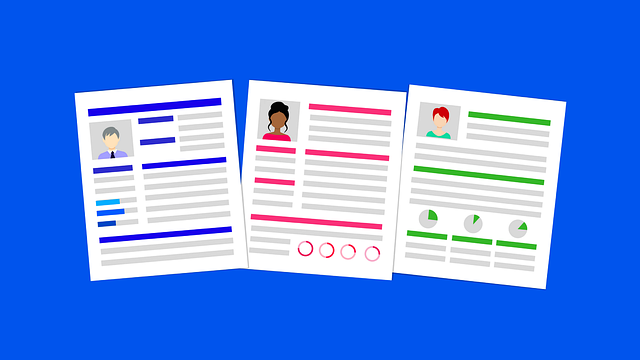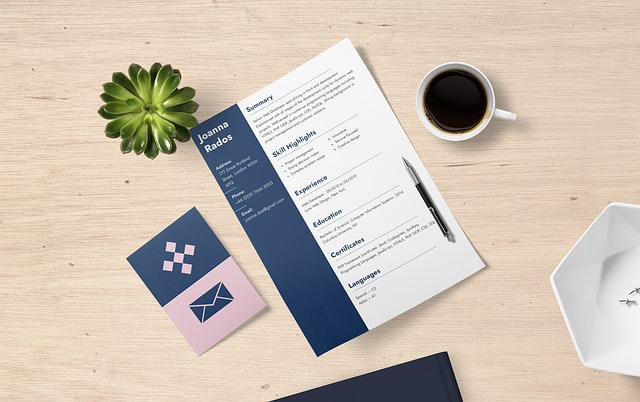In today’s job market, having a strong online presence is crucial. A portfolio and a resume are both important tools for showcasing your skills and experience to potential employers. While a resume provides a concise summary of your work history and qualifications, a portfolio allows you to showcase specific examples of projects you’ve worked on and the results you achieved.
What is a portfolio?
(Image by Tomislav Kaučić from Pixabay )

A portfolio is a collection of work that showcases your skills, abilities, and achievements. It’s an opportunity for you to present examples of your best work in a creative way that highlights your unique talents and experience. A portfolio can take many forms, including physical binders or digital websites.
Portfolios are often used by professionals such as photographers, designers, writers, artists, and marketers to showcase their past projects to potential clients or employers. However, anyone can create a portfolio regardless of their profession.
A good portfolio should demonstrate your strengths and provide evidence of the results you’ve achieved in previous projects. This could include case studies, testimonials from clients or coworkers, samples of completed work products like brochures or marketing campaigns.
Creating a strong portfolio takes time and effort but it can be worth it if done correctly. Not only does it help show off what you have accomplished but also sets you apart from other candidates who may only rely on resumes to market themselves.
What is a resume?
(Image by Coffee Bean from Pixabay )

A resume is a formal document that summarizes an individual’s work experience, education, skills and achievements. It is typically used in job applications to showcase the candidate’s qualifications for a particular role. A well-written resume can make all the difference in landing an interview with a potential employer.
A good resume should highlight your most relevant experience and skills related to the position you are applying for. This means tailoring your resume to each job application rather than sending out one generic version. Your resume should be easy-to-read and visually appealing, using bullet points and clear headings.
When creating a resume, it’s important to include key information such as your contact details, work history (including dates of employment), education level and any relevant certifications or awards earned. You may also want to add a professional summary at the beginning of your resume which briefly explains who you are as a professional.
Resumes play an essential role in showcasing your qualifications when applying for jobs. By tailoring each version of your resume to fit specific roles and highlighting key experiences and skills, you increase your chances of making it past initial screening processes and landing interviews with potential employers.
Portfolio Vs. Resume – Key differences
While a portfolio and a resume serve the same purpose – to showcase your skills, experience and qualifications to potential employers – they are quite different in their presentation and contents.
Firstly, a resume is typically shorter than a portfolio. It’s often limited to one or two pages of bullet points that highlight your work history, education, skills and achievements. On the other hand, a portfolio can be longer as it includes samples of your work such as writing samples, design projects or case studies.
Secondly, resumes tend to be more standardized in terms of structure and format whereas portfolios have more room for creativity. A resume follows strict guidelines on what information should be included while portfolios can vary greatly depending on the type of work being showcased.
Thirdly, resumes are usually used when applying for specific job openings whereas portfolios may be presented at any time during the hiring process. For example, you could bring along your portfolio to an interview even if you’ve already submitted your resume.
While both portfolios and resumes have their own unique advantages when presenting yourself professionally; it ultimately comes down to personal preference with regards to which one best suits you.
Should you have both a portfolio and a resume?
Having both a portfolio and resume can also demonstrate your versatility as an applicant. A well-crafted portfolio can showcase additional talents that may not be easily conveyed on a traditional resume.
However, it’s important to note that creating both a portfolio and resume takes time and effort. It’s crucial to carefully consider the industry you’re applying in before deciding whether or not you need both. Some industries may place more emphasis on portfolios over resumes while others require only one document.
How to create a portfolio
Creating a portfolio can seem like a daunting task, but with the right approach and tools, it can be an enjoyable and rewarding experience. Here are some steps to help you create an impressive portfolio:
- Identify your goals: Before creating your portfolio, ask yourself what you want to achieve with it. Do you want to showcase your skills or attract potential clients? Knowing your objectives will help guide the content and design of your portfolio.
- Choose a platform: There are various platforms available for creating digital portfolios such as Wix, Squarespace, Behance, and Adobe Portfolio. Select one that aligns with your goals and preferences.
- Showcase your best work: Include examples of projects that highlight both your technical abilities and creativity in different formats (e.g., images, videos, audio files).
- Keep it organized: Make sure that the layout is clean and easy to navigate by using clear headings or categories.
- Add context: Provide brief descriptions of each project including the challenges faced during creation process so people understand why they should care about them.
- Remember that every piece of content in the portfolio should serve its purpose – telling a story about who you are as a professional artist or designer without saying much!
How to create a resume
When it comes to creating a resume, there are a few key elements you should include. Firstly, ensure that your name and contact details are prominent at the top of the page. This should be followed by a summary or objective statement that highlights your skills and experience.
Next, list your relevant work experience starting with your most recent job first. Be sure to include specific achievements and responsibilities for each role. If you have limited work experience, consider including volunteer or internship positions as well.
Education is also an important component of any resume. List all degrees earned along with any certifications or licenses relevant to the position you are applying for.
Don’t forget to mention any special skills such as language proficiency or computer software proficiency.
It’s important to keep in mind that employers often receive numerous resumes so making yours stand out is crucial. Use bullet points rather than lengthy paragraphs and make sure everything is easy to read and visually appealing. With these tips in mind, you’ll be well on your way to creating an impressive resume!
What are 5 important things for a portfolio?
When it comes to creating a portfolio, there are certain things that can make all the difference in showcasing your skills and experience. Here are five important elements to include:
- Variety of work – A strong portfolio should showcase a variety of work that demonstrates your range of skills and abilities. Include samples from different projects or clients to show versatility.
- Clear organization – Your portfolio should be well-organized with clear categories or sections for each type of work you’re showcasing. This makes it easy for potential employers or clients to navigate and find what they’re looking for.
- High-quality visuals – Whether you’re including design work or photography, high-quality visuals are essential. Make sure images are crisp, clear, and properly formatted for online viewing.
- Contextual information – For each piece in your portfolio, provide some context about the project or client you worked with. This helps potential employers understand how your skills were applied in real-world scenarios.
- Contact information – Don’t forget to include contact information so that potential clients or employers can easily get in touch with you if they’re interested in working together.
By keeping these elements in mind as you create your portfolio, you’ll be able to showcase yourself effectively and stand out among other candidates vying for the same job opportunities.
Featured Image By – Biljana Jovanovic from Pixabay








